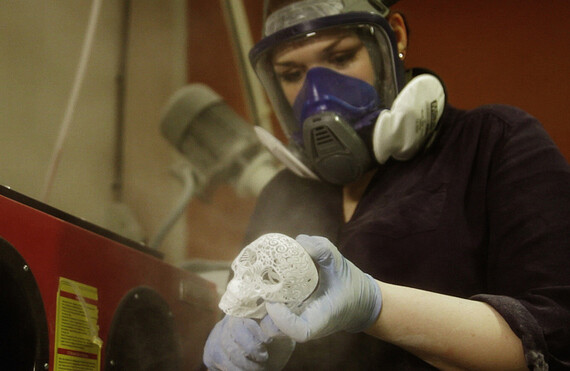Printing in three dimensions, once the domain of science fiction, is fast emerging as the new frontier in manufacturing, with potentially radical effects on patterns of global trade and development. The ability to design a product in one country and transmit it to another for output promises to level at least a fraction of the global labor market, and unlock the creativity of inventors and entrepreneurs everywhere. I corresponded with William Hoyle, chief executive of techfortrade, about the future of this technology in the developing world.
EVAN O'NEIL: 3D printing is being hailed as a revolutionary step in manufacturing, and techfortrade is trying to leverage it to deliver social benefit in developing countries. Looking five to ten years ahead, what do you envision?
WILLIAM HOYLE: I believe there are exciting future opportunities for 3D printing in a developing world context. Certainly in Africa, Internet-based retailing is in its infancy, yet mobile phone penetration and Internet connectivity via 3G networks is expanding rapidly. In addition, many students in science and technology departments in universities in Africa are acquiring the skills to use computer-aided design (CAD) software. Of course, we also know that particularly in East and South Africa there are a growing number of "tech hubs" such as the iHub in Nairobi, with a growing population of smart young software designers.
So many of the conditions for expansion are in place, and most importantly, so is the demand. 3D printing will support local manufacturing, reduce the tooling costs for short product runs, and allow new products to be tested in the market without expensive tooling. Access to digital data will enable spare parts to be manufactured locally for anything from agricultural machinery to automobiles, and recycling opportunities will provide feedstock for the printers as well as better earning opportunities for "waste pickers."
EVAN O'NEIL: You just held a global competition, the 3D4D Challenge, to showcase innovative applications of 3D printing. What was the result at the final event in London?
WILLIAM HOYLE: We had seven great finalists from the United States, Canada, Israel, India, and Kenya. The winning entry came from a team called Washington Open Object Fabricators (WOOF) from The University of Washington.
WOOF's winning project will enable waste plastic to be used as filament for 3D printing machines, to create new products. The winning team—Bethany Weeks, Matthew Rogge, and Brandon Bowman—plan to work with Water for Humans, an NGO based in the United States, to address local issues in water and sanitation in Oaxaca, Mexico.

Contest winner Matthew Rogge of WOOF. © 2012 3D4D Challenge.
EVAN O'NEIL: Were there any entries that really surprised you with the way they applied the technology?
WILLIAM HOYLE: They were all innovative in their own way. Probably the most innovative is a project led by Tom Fripp and Steve Roberts from Fripp Design in the United Kingdom. They have developed a process that uses 3D printing to manufacture customized soft-tissue prostheses, using a technique that will produce a prosthetic in a less obtrusive, faster, and significantly more affordable way. This opens up the possibility of such prosthetics being made available to patients in the developing world—something that will enable people to lead more normal and dignified lives, without the stigma of facial damage.
EVAN O'NEIL: What materials are manufacturers using? Have there been efforts to source and produce those materials sustainably?
WILLIAM HOYLE: The most common technique for 3D printing is fused deposition modeling (FDM). This involves a semi-liquid material being extruded from a print head. Most FDM 3D printers can print with both ABS (acrylonitrile butadiene styrene), as well as a biodegradable plastic called PLA (polylactic acid) that is produced from organic alternatives to oil. There are already advances in this technology that open up the potential for recycled plastic to be used, as well as initiatives that will lead to the use of other biomass materials.
FDM printers have also been developed that can output other semi-liquid materials, ranging from concrete to food printers that can print in cake icing!
Another printing technique involves selective laser sintering (SLS). This process uses a powder tray and a laser to fuse powder granules together to create the object. At present, SLS printers can print in aluminium, ceramics, glass, stainless steel, nylon, glass, ceramics, and various alloys including cobalt chrome.

Lip and nose prosthesis by Fripp Design and Research. © 2012 3D4D Challenge.
EVAN O'NEIL: During the American presidential election we've heard calls for a revival of domestic manufacturing, and recently several 3D factories have opened here in New York City. What are the potential impacts on the labor market in developing countries? Will products be printed for domestic markets or more for export?
WILLIAM HOYLE: I think there are two scenarios here. The first involves local manufacture of products or spares and the second the remote printing of products designed in the developing world. It's entirely possible to imagine, for example, ethnic jewelry, created based on tribal designs, to be made available as "Fair Trade" digital data for printing in another part of the world.
EVAN O'NEIL: Can 3D manufacturing expedite technology transfer to poorer countries, through open source file-sharing or other means?
WILLIAM HOYLE: Definitely, and to a certain extent that's happening domestically already through sites like thingiverse.
EVAN O'NEIL: How does the industry defend against piracy, or is this an issue at all?
WILLIAM HOYLE: I think it's an issue, but it's already an issue that is being faced in the media industry. I guess the question is will manufacturers decide to offer "official" digital files for a nominal price through some sort of multi-vendor site, a bit like iTunes. There's little cost to the manufacturer and it definitely ticks the environment-friendly box if it means repair and reuse rather than replacement; especially in a market where replacement might be unaffordable anyway!
EVAN O'NEIL: Are there any printers or projects up and running in the developing world already? Are there potential linkages with other ICT innovations?
WILLIAM HOYLE: While setting up the 3D4D Challenge, I had the opportunity to visit universities and hackerspaces in India, South Africa, and Kenya where I saw students and tech entrepreneurs already working with their ideas, using this technology. I think these "fab labs" and hackerspaces will grow in number and be incubators of developing world innovation.





